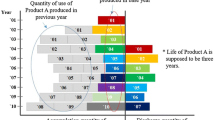Abstract
Material dematerialization is a basic approach to reduce the pressure on the resources and environment and to realize the sustainable development. The material flow analysis and decomposition method are used to calculate the direct material input (DMI) of 14 typical mining cities in Northeast China in 1995–2004 and to analyze the dematerialization and its driving factors in the different types of mining cities oriented by coal, petroleum, metallurgy and multi-resources. The results are as follows: 1) from 1995 to 2006, the increase rates of the DMI and the material input intensity of mining cities declined following the order of multi-resources, metallurgy, coal, and petroleum cities, and the material utilizing efficiency did following the order of petroleum, coal, metallurgy, and multi-resources cities; 2) during the research period, all the kinds of mining cities were in the situation of weak sustainable development in most years; 3) the pressure on resources and environment in the multi-resources cities was the most serious; 4) the petroleum cities showed the strong trend of sustainable development; and 5) in recent years, the driving function of economic development for material consuming has continuously strengthened and the controlling function of material utilizing efficiency for it has weakened. The key approaches to promote the development of circular economy of mining cities in Northeast China are put forward in the following aspects: 1) to strengthen the research and development of the technique of resources’ cycling utilization, 2) to improve the utilizing efficiency of resources, and 3) to carry out the auditing system of resources utilization.
Similar content being viewed by others
References
Ang B W, Zhang F Q, Choi K H, 1998. Factorizing changes in energy and environmental indicators through decomposition. Energy, 23(6): 489–495. DOI: 10.1016/S0360-5442(98)00016-4
Bernardini O, Galli R, 1993. Dematerialization: Longterm trends in the intensity of use of materials and energy. Future, 25(4): 431–448. DOI: 10.1016/0016-3287(93)90005-E
Chen Xiaoqiu, Zhao Tingting, Guo Yuquan et al., 2003. Material input and output analysis of Chinese economy system. Acta Scientiarum Naturalium Universitatis Pekinensis, 39(4): 538–547. (in Chinese)
Colombo U, 1988. The Technology Revolution and the Restructuring of the Global Economy. In: Muroyama J H et al. (eds.). Globalization of Technology: International Perspectives. Washington, D.C.: National Academy Press.
European Communities, 2001. Economy-wide Material Flow Accounts and Derived Indicators-A Methodological Guide. Luxembourg: Office for Official Publications of the European Communities, 15–44.
Fan Jie, Sun Wei, Fu Xiaofeng, 2005. Problem, reasons and strategies for sustainable development of mining cities in China. Journal of Natural Resources, 20(1): 68–77. (in Chinese)
Feng Zhijun, 2007. Normalization theory study on circular economy. China Population, Resources and Environment, 17(4): 10–13. (in Chinese)
Heilongjiang Statistical Bureau, 1996–2007. Heilongjiang Statistical Yearbook 1996–2007. Beijing: China Statistics Press. (in Chinese)
Helmut Schutz, Welfens J M, 2004. Sustainable development by dematerialization in production and consumption-strategy for the new environmental policy in Poland. http://www.wuppererinst.org/Publikayionen/ WP/WP103.pdf. 2004-09-25.
Heman R, Arkekani S A, Ausubel J H, 1989. Dematerialization. In: Ausuelb J H et al. (eds.). Technology and Environment. Washington, D.C.: National Academy Press.
Huang Heping, Bi Jun, Zhang Bing et al., 2007. A critical review of material flow analysis. Acta Ecological Sinica, 27(1): 368–369. (in Chinese)
Huang Heping, Bi Jun, 2006. Evaluating regional circular economy based on MFA: A case study in Wujin District of Changzhou City. Resources Science, 28(6): 20–27. (in Chinese)
Jilin Statistical Bureau, 1996–2007. Jilin Statistical Yearbook 1996–2007. Beijing: China Statistics Press. (in Chinese)
Li Bo, Tong Lianjun, 2008. Vulnerability and sustainable development mode of coal cities in Northeast China. Chinese Geographical Science, 18(2): 119–126. DOI: 10.1007/s11769-008-0119-0
Li Huiming, Wang Lei, 2008. Decomposition analysis on dematerialization for the further development of circular economy. Resources Science, 30(10):1484–1490. (in Chinese)
Liaoning Statistical Bureau, 1996–2007. Liaoning Statistical Yearbook 1996–2007. Beijing: China Statistics Press. (in Chinese)
Liu Jingzhi, Wang Qing, Gu Xiaowei et al., 2005. Direct material input and dematerialization analysis of Chinese economy. Resources Science, 27(1): 46–51. (in Chinese)
Long Ruyin, 2005. Sustainable development of Chinese mining city: Theories and methods. Xuzhou: China University of Mining and Technology Press. (in Chinese)
National Bureau of Statistics of China, 1996–2007. China City Statistical Yearbook. Beijing: China Statistics Press. (in Chinese)
Peng Jian, Wang Yanglin, Wu Jiansheng, 2006. Progress and Prospect of material flow analysis in the ecological assessment of regional sustainale development. Resources Science, 28(6): 189–195. (in Chinese)
Peter Bartelmus, 2004. Dematerialization and capital maintenance: Two sides of the sustainability coin. http://www.wupperinst.org/Publikationen/WP/WP.2004-09-25.
Shen Lei, Cheng Jing, 1999. A preliminary discussion on the mechanism of mining cities for sustainable development. Resources Science, 21(1): 44–50. (in Chinese)
Song Yuxiang, Ding Sibao, Chu Li et al., 2005. Study on continuative industry of resource-based cities in Northeast China. In: Ma Kai (ed.). The 11th Five-Year Plan Strategies. Beijing: Beijing Science & Technology Press. (in Chinese)
Wang Qingyun, 2003. Study on economic transformation of resources-based cities. Beijing: China Economic Publishing House. (in Chinese)
Wernick I, Ausbel J H, 1996. National material flows and the environment. Annual Review Energy Environment, 20: 463–492.
Zhang Sifeng, Lei Juan, 2006. Analyzing dematerialization of Shanxi province based on MFA. Resources Science, 28(4): 145–150. (in Chinese)
Zhang Yinbo, Xia Zhixin, Chen Xingeng et al., 2007. Dynamics of regional sustainable development based on material flow analysis. Resources Science, 29(6): 212–218. (in Chinese)
Author information
Authors and Affiliations
Corresponding author
Additional information
Foundation item: Under the auspices of Key Program of National Natural Science Foundation of China (No. 40635030), National Natural Science Foundation of China (No. 40571041)
Rights and permissions
About this article
Cite this article
Qiu, F., Tong, L., Zhang, H. et al. Decomposition analysis on direct material input and dematerialization of mining cities in Northeast China. Chin. Geogr. Sci. 19, 104–112 (2009). https://doi.org/10.1007/s11769-009-0104-2
Received:
Accepted:
Published:
Issue Date:
DOI: https://doi.org/10.1007/s11769-009-0104-2




